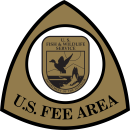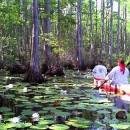What We Do
The National Wildlife Refuge System is a series of lands and waters owned and managed by the U.S. Fish and Wildlife Service. Wildlife conservation is at the heart of the refuge system. It drives everything we do from the purpose a refuge is established, to the recreational activities offered there, to the resource management tools we use. Selecting the right tools helps us ensure the survival of local plants and animals and helps fulfill the purpose of the refuge.
At DeSoto National Wildlife Refuge, staff work toward restoring important habitat for wildlife along the heavily altered Missouri River floodplain. Land clearing, drainage projects, river channelization and flood control measures during the past 150 years have transformed the Missouri River floodplain from a diverse wildlife habitat to mainly farmland. At DeSoto National Wildlife Refuge, areas that used to be farmed have been converted back to natural habitats such as wetlands, prairies and bottomland forests to mimic the historic floodplain habitat and benefit the native plants and wildlife.
Management and Conservation
Refuges use a wide range of land management tools based on the best science available. Some refuges use prescribed fires to mimic natural fires that would have cleared old vegetation from the land helping native plants regenerate and local wildlife to thrive. Other refuges contain wilderness areas where land is largely managed passively. The management tools used are aimed at ensuring a balanced conservation approach where both wildlife and people will benefit. At this field station our conservation toolbox includes:
Wetland Management
Wetland management is an important conservation tool that helps the refuge fulfill its purpose as a sanctuary and resting place for migratory birds. Staff utilize water control structures, pumps and wells to allow for wetlands to be seasonally flooded. Draw downs and occasional disturbances (like disking or cultipacking) encourage seed germination of important wetland plants which provide nourishment for waterfowl and also benefit a diversity of wildlife throughout the season.
Grassland Management
Prescribed burning is one tool used to maintain the restored tracts of grassland habitat. Typically burns are done in the spring and help to control woody vegetation encroachment and to promote native grasses and wildflowers.
Forest Management
The bottomland cottonwood forest habitat requires flooding and exposed mud flats for cottonwood seeds to germinate. Refuge staff have taken advantage of recent flooding to allow for early growth cottonwood forests to flourish. In mature cottonwood stands, staff use machinery to clear undesirable undergrowth to create a cottonwood savanna habitat.
DeSoto Lake Management
Refuge staff work with the state fisheries programs to stock the lake with walleye and blue catfish. Tree piles, rock piles and artificial structure structure
Something temporarily or permanently constructed, built, or placed; and constructed of natural or manufactured parts including, but not limited to, a building, shed, cabin, porch, bridge, walkway, stair steps, sign, landing, platform, dock, rack, fence, telecommunication device, antennae, fish cleaning table, satellite dish/mount, or well head.
Learn more about structure are submerged annually to provide shelter for fish species. Occasional draw-downs of lake help to promote shoreline vegetation which benefits fish as well as waterfowl.
Our Projects and Research
Our National Wildlife Refuges are places for everyone to learn about and discover the outdoors. This opportunity is utilized by numerous local grad students from local universities and other government organizations over the years, researching parts the wide variety of wildlife and plant species that use or call DeSoto National Wildlife Refuge their home. If interested in performing a research project on refuge lands please contact:
Besides just grad student research, DeSoto National Wildlife Refuge also utilizes citizen science projects to help improve our understanding of the natural world, enabling us to evaluate our management practices for our wildlife.
Law Enforcement
U.S. Fish and Wildlife Service law enforcement officers have a wide variety of duties and responsibilities. Officers’ help visitors understand and obey wildlife protection laws. They work closely with state and local government offices to enforce federal, state and refuge hunting regulations that protect migratory birds and other game species from illegal take and preserve legitimate hunting opportunities. Some other duties include patrolling closed areas, maintaining relationships with neighboring landowners, maintaining refuge boundaries and participating in public events related to refuge issues.
Laws and Regulations
Laws, acts and establishing authorities provide the basic framework for all management decisions on a national wildlife refuge national wildlife refuge
A national wildlife refuge is typically a contiguous area of land and water managed by the U.S. Fish and Wildlife Service for the conservation and, where appropriate, restoration of fish, wildlife and plant resources and their habitats for the benefit of present and future generations of Americans.
Learn more about national wildlife refuge . At DeSoto National Wildlife Refuge, the establishing authority as a migratory bird sanctuary guides the habitat management direction. This also factors into the public uses that are permitted on the refuge. All public uses must be found compatible with the mission of the refuge. Some uses that are found compatible may require a special use permit to control the numbers and potential impact. The overall goal is to provide the public with a place to enjoy nature and wildlife without impacting the refuges ability to carry out its mission.









